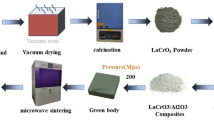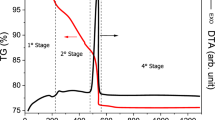Abstract
Mixed electronic and protonic conductor materials were prepared using BaCe0.8Y0.1M0.1O3−δ (BCYM) as the protonic conductive phase and Ce0.8Y0.1M0.1O2−δ (MYDC) as the electronic conductive phase (in reducing atmosphere), with M=Y, Yb, Er, Eu. Dense specimens of these ceramic/ceramic composite materials (cercers) were prepared by solid-state reactive sintering: all the precursors for BCYM and MYDC were mixed, pelletized, and fired without any pre-calcination step of the individual ceramic phases. The X-ray diffraction patterns revealed the presence of the two desired phases. The study of the lattice parameters showed that the Y and M co-dopants were fairly well distributed between the perovskite phase BCYM and the fluorite phase MYDC. This interesting discovery is of importance for the preparation of two-phase ceramic materials. In addition to the structural study, the samples were analyzed by scanning electron microscopy and were found to be free of any undesirable phases. The two ceramic phases could easily be distinguished using the back-scattered electron mode, with grains between 10 and 30 microns. Energy dispersive X-ray spectroscopy confirmed the distribution of the co-dopant between the two phases.








Similar content being viewed by others
References
Qi X, Lin YS (2000) Electrical conduction and hydrogen permeation through mixed proton–electron conducting strontium cerate membranes. Solid State Ion 130:149–156
Son SJ, Wachsman ED, Rhodes J, Dorris SE, Balachandran U (2004) Hydrogen permeability of SrCe1–xMxO3−δ (x = 0.05, M = Eu, Sm). Solid State Ion 167:1–10
Bentzer HK, Bonanos N, Phair JW (2010) EMF measurements on mixed protonic/electronic conductors for hydrogen membrane applications. Solid State Ion 181:249–255
Erdal S, Kalland LE, Hancke R, Polfus J, Haugsrud R, Norby T, Magraso A (2012) Defect structure and its nomenclature for mixed conducting lanthanum tungstates La28−xW4+xO54+3x/2. Int J Hydrog Energy 37:8051–8055
Escolastico S, Solis C, Serra JM (2011) Hydrogen separation and stability study of ceramic membranes based on the system Nd5LnWO12. Int J Hydrog Energy 36:11946–11954
Zuo CD, Lee TH, Dorris SE, Balachandran U, Liu ML (2006) Composite Ni–Ba(Zr0.1Ce0.7Y0.2)O3 membrane for hydrogen separation. J Power Sources 159:1291–1295
Yan LT, Sun WP, Bi L, Fang SM, Tao ZT, Liu W (2010) Influence of fabrication process of Ni BaCe0.7Zr0.1Y0.2O3−d cermet on the hydrogen permeation performance. J Alloys Compd 508:5–8
Yan LT, Sun WP, Bi L, Fang SM, Tao ZT, Liu W (2010) Effect of Sm-doping on the hydrogen permeation of Ni-La2Ce2O7 mixed protonic-electronic conductor. Int J Hydrog Energy 35:4508–4511
Fish JS, Ricote S, Holgate T, Lenrick F, Wallenberg LR, O’Hayre R, Bonanos N (2013) Synthesis by spark plasma sintering of a novel protonic/electronic conductor composite: BaCe0.2Zr0.7Y0.1O3−d/Sr0.95Ti0.9Nb0.1O3−d (BCZY27/STN95). J Mater Sci 48:6177–6185. doi:10.1023/A:1011230821605
Elangovan S, Nair GB and Small TA (2007) Ceramic mixed protonic/electronic conducting membranes for hydrogen separation, Patent US 7,258,820 B2 Ceramatec Inc
Fabbri E, Pergolesi D, Traversa E (2010) Materials challenges toward proton-conducting oxide fuel cells: a critical review. Chem Soc Rev 39:4355–4369
Kreuer KD (2003) Proton-conducting oxides. Annu Rev Mater Res 33:333–359
Chiodelli G, Malavasi L, Tealdi C, Barison S, Battagliarin M, Doubova LM, Fabrizio M, Mortalo C, Gerbasi R (2009) Role of synthetic route on the transport properties of BaCe1−x Y x O3 proton conductor. J Alloys Compd 470:477–785
Wang S, Zhao F, Zhang L, Brinkman K, Chen F (2010) Stability and electrical property of Ba1−xSrxCe0.8Y0.2O3−d high temperature proton conductor. J Alloys Compod 506:263–267
Yang L, Wang S, Blinn K, Liu M, Liu Z, Cheng Z, Liu M (2009) Enhanced Sulfur and Coking Tolerance of a Mixed Ion Conductor for SOFCs: BaZr0.1Ce0.7Y0.2−xYbxO3−d. Science 326:126–129
Ding H, Xie Y, Xue X (2011) Electrochemical performance of BaZr0.1Ce0.7Y0.2−xYbxO3−d electrolyte based proton-conducting SOFC solid oxide fuel cell with layered perovskite PrBaCo2O5+d cathode. J Power Sources 19:2602–2607
Dincer E (1991) Behavior of pure and doped ceria in molten alkali-carbonates, PhD dissertation, Case Western Reserve University
Park SY, Yoo HI (2005) Defect-chemical role of Mn in Gd-doped CeO2. Solid State Ion 176:1485–1490
Guan X, Zhou H, Wang Y, Zhang J (2008) Preparation and properties of Gd3+ and Y3+ co-doped ceria-based electrolytes for intermediate temperature solid oxide fuel cells. J Alloys Compd 464:310–316
Norby T, Larring Y (2000) Mixed hydrogen ion-electronic conductors for hydrogen permeable membranes. Solid State Ion 136–137:139–148
Tong J, Clark D, Hoban M, O’Hayre R (2010) Cost-effective solid-state reactive sintering method for high conductivity proton conducting yttrium-doped barium zirconium ceramics. Solid State Ion 181:496–503
Coors WG (2011) Co-ionic conduction in protonic ceramics of the solid solution, BaCexZr(1−x)Y(y−x)O3−d; part I: fabrication and microstructure, ceramic materials, book 3. Intech, Croatia
Tong J, Clark D, Bernau L, Sanders M, O’Hayre R (2010) Proton-conducting yttrium-doped barium cerate ceramics synthesized by a cost-effective solid-state reactive sintering method. J Mater Chem 20:6333–6341
Ricote S, Bonanos N, Manerbino A, Coors WG (2012) Conductivity study of dense BaCexZr(0.9−x)Y0.1O(3−d) prepared by solid state reactive sintering at 1500°C. Int J Hydrog Energy 37:7954–7961
Takeuchi K, Loong CK, Richardson JW Jr, Guan J, Dorris SE, Balachandran U (2000) The crystal structures and phase transitions in Y-doped BaCeO3: their dependence on Y concentration and hydrogen doping. Solid State Ion 138:63–77
Shannon RD (1976) Revised effective ionic radii and systematic studies of interatomic distances in halides and chalcogenides. Acta Crystallogr A 32:751–767
Bevan DJM, Summerville B (1979) Mixed rare earth oxides. In: Gschneidner KA, Eyring L (eds) Handbook of the physics and chemistry of rare earths. Westralian Sands Limited, Capel
Hong SJ, Virkar AV (1995) Lattice parameters and densities of rare-earth oxide doped ceria electrolytes. J Am Ceram Soc 78:433–439
Zhang TS, Ma J, Huang HT, Hing P, Xia ZT, Chan SH, Kilner JA (2003) Effects of dopant concentration and aging on the electrical properties of Y-doped ceria electrolytes. Solid State Sci 5:1505–1511
Kim DJ (1989) Lattice-parameters, ionic conductivities, and solubility limits in fluorite-structure MO2 oxide (M = Hf4+, Zr4+, Ce4+, Th4+, U4+) solid-solutions. J Am Ceram Soc 72:1415–1421
Shing OP, Ping TY, Hin TYY, Zainal Z (2011) Synthesis and ionic conductivity of mechanically synthesized yttrium-doped ceria solid solutions. J Appl Sci 11:1285–1290
Acknowledgements
The authors are thankful to Dr. Christopher Knee (Chalmers University, Sweden) and Daniel Clark (Colorado School of Mines, USA) for useful discussions, to Dr. Sean Babiniec for a thorough proof reading as well as to Dr. Elizabeth Young-Dohe (CoorsTek) for running some of the XRD measurements.
Author information
Authors and Affiliations
Corresponding author
Rights and permissions
About this article
Cite this article
Ricote, S., Manerbino, A., Sullivan, N.P. et al. Preparation of dense mixed electron- and proton-conducting ceramic composite materials using solid-state reactive sintering: BaCe0.8Y0.1M0.1O3−δ–Ce0.8Y0.1M0.1O2−δ (M=Y, Yb, Er, Eu). J Mater Sci 49, 4332–4340 (2014). https://doi.org/10.1007/s10853-014-8129-z
Received:
Accepted:
Published:
Issue Date:
DOI: https://doi.org/10.1007/s10853-014-8129-z




